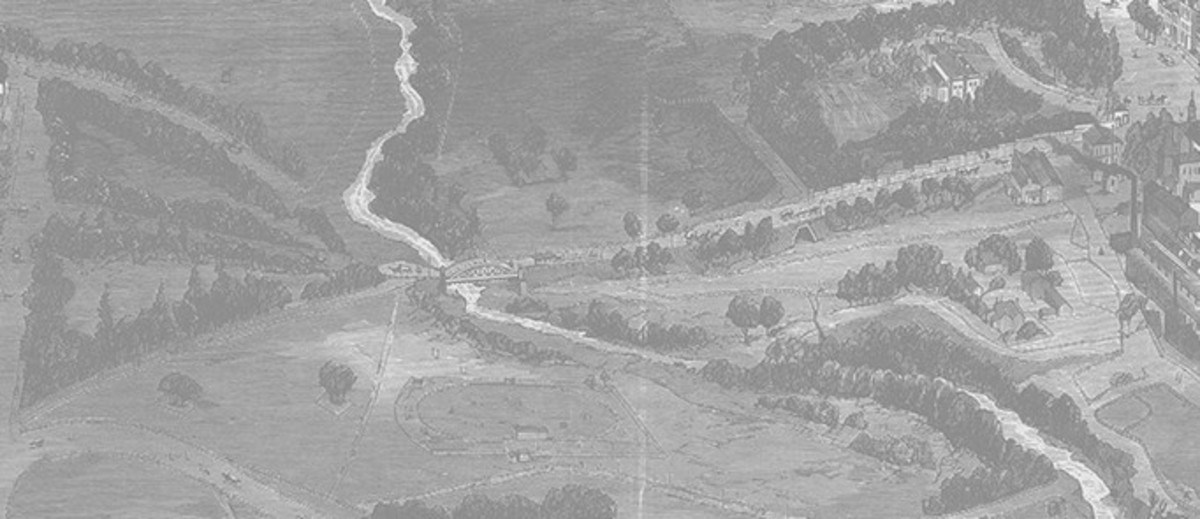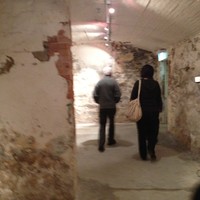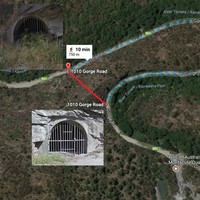Thing
ContributeAlong with ghost stories, tunnel tales are a perennial favourite in the popular press, and are cheerfully perpetuated by tour operators and publicans everywhere. It seems the public just can’t get enough about hidden worlds and mysterious goings-on just beneath our feet. But how much is fact and how much is fiction?
Definition of a tunnel
The Concise Oxford Dictionary’s definition of a tunnel is:
An artificial subterranean passage through a hill etc, or under a road or river, especially for a road or rail.
A tunnel is a passage or corridor connecting two spaces. That is, it must lead somewhere. It should be open at both ends. Some definitions specify that a tunnel must be at least twice as long in the horizontal dimension as it isin the vertical. Thus a tunnel is not a cellar, basement, or other underground room. Within the restrictions of this definition following are two examples of Adelaide’s tunnel stories.
King William Street Tunnel
A number of different stories seem to converge on this particular tunnel. These include:
- That there was a tunnel running from Government House to Parliament House, to facilitate secret meetings between Parliamentarians and the Governor;
- That there was a private underground passage linking Parliament House and the Adelaide Railway station so MPs could catch their trains without having to brave the weather;
- That a tunnel extended underground beneath North Terrace, all the way to Pulteney Street, or even as far as Frome Road;
- That an underground railway branch line ran through the tunnel; and
- that it incorporated one or more underground station platforms, and was used to deliver goods to various North Terrace businesses via a network of connecting tunnels.
There was definitely a tunnel under King William Road. Indeed, it is still there, though filled in with rubble. It runs diagonally under the road, between where the Festival Centre now stands and just north of the boundary of the Government House. This rather modest little tunnel has given rise to most, if not all, of the stories above.
The tunnel was rediscovered in 1973, around the time of the opening of the new Festival Centre. As part of this development, reconstruction work was taking place on King William Road. It was known from the old Adelaide City Council records that there had once been a tunnel under the road, through which a railway spur line to the old Exhibition Grounds used to pass. The opportunity was taken to expose the tunnel to see whether it would be worthwhile restoring it as a pedestrian sub-way. A section of the tunnel was excavated, revealing a bluestone-lined tunnel 15 feet wide and at least 30 feet long. The Council thought that, restored to its original appearance, the tunnel would make a grand addition and counterpoint to the modern architectural form of the new Festival Centre precinct, whilst allowing Festival patrons to cross the road in safety. And it would be a tourist attraction. The State Government agreed to contribute towards the estimated $35,000 cost of the project, plans were drawn up, and tenders called.
Alas, it turned out that the initial estimates were grossly inadequate, and with the projected costs escalating to $90,000 or possibly $140,000 for complete restoration, the project was abandoned. The test excavations were refilled with quarry rubble, and sealed with a temporary surface coat.
The tunnel has an interesting history: It dates back to the very early days of the colony, well before the railway. This type of underpass was known as a 'cattle creep', or 'cattle arch', and this gives a clue to its function as a means of permitting grazing livestock to cross from paddocks either side of the road, without obstructing traffic or straying.
From around 1850 a detachment of the Royal Sappers and Miners, engaged on survey work, was housed in cottages on the site of the present Parade Ground, and their horses were stabled on the open ground to the west. Horses belonging to the South Australian Mounted Police, based on North Terrace, were also kept here, and it became known as the Police Paddock.
When King William Street was extended through the Government Domain in the mid 1850s, and the first City Bridge was constructed across the Torrens, the barracks were effectively cut off from the stables and paddocks on the other side of the road. The bridge had to be built high enough to escape the floods, which periodically cut off North Adelaide from the city proper, and this meant substantial earthworks were needed to raise the level of the road on the southern approach. The steep embankment thus created was an obstacle, which was dealt with by including in the plans 'a small bridgeway to admit of communication with the police paddock' (report prepared for the Legislative Council by William Bennett Hays, Colonial Architect and Supervisor of Works).
It seems highly likely that the 'bridgeway' referred to is the tunnel that exists today, and that it was built as part of the construction works for the new road. An alternative theory is that the need for the tunnel only became apparent after the road was completed, and that it was constructed by the Sappers and Miners.
However, given the above evidence it is much more probable that the underpass was constructed at the same time, and by the same government contractors engaged to carry out the roadworks. Work commenced on the embankment in December 1854, and the South Australian Register of 1 June 1855 reported that the roadway linking King William Street to the new bridge was complete and open to traffic.
In 1886 the tunnel was deepened and underpinned to accommodate a railway branch line connecting the Exhibition Grounds with Adelaide Railway Station in preparation for the Jubilee International Exhibition of the following year.
The line ran eastwards from the north side of the station, via a shallow cutting alongside the City Baths, under King William Road and along the southern side of the Torrens Parade Ground. From there it ran parallel to the river before veering south, passing through the British Machinery Hall and terminating inside the northern annexe of the Exhibition Building on the western side of Frome Road. It was used for& transporting exhibits of heavy machinery and other goods to the grounds. These included a locomotive and tender, built in Ballarat, which were installed at the end of the track on 20 May 1887, so it can be assumed the line would have been opened shortly before that date.
The Jubilee Exhibition ran until January 1888, after which the line continued in use, providing access to the Exhibition Building and Jubilee Oval for various purposes for another forty years. It was used to transport construction materials for new university buildings, as well as exhibits for the Chamber of Manufactures' exhibitions and Royal Agricultural and Horticultural Society's spring and autumn shows.
The line was not intended for passenger transport, and had no platform at Adelaide station, but between 1899 and 1902 it did carry passenger trains transporting Boer War troops from the Parade Ground to Port Adelaide for embarkation for South Africa. During the Spanish Influenza epidemic in 1919 the branch line was used to transport around 600 people brought by train from Melbourne to a temporary quarantine station set up in tents on the Jubilee Oval.
After the Show Society relocated to Wayville in 1924, the line was considered to be redundant and the tracks were taken up in August 1927. The cutting through Elder Park was filled in the following year, and it is probable that the tunnel was backfilled and sealed at the same time. Since then, both entrances have been blocked off with tons of earth as the road above has been progressively widened.
The Treasury Tunnels – Medina Grand Hotel
The Treasury Tunnels are another open secret, especially since the publicity surrounding the redevelopment of the old Treasury Building as the Medina Grand Hotel. The Treasury complex was built as government offices, and constructed in several stages. The present façades date from 1858 through to 1876 though there are still remnants of the original 1839 structure within the building. For over 150 years, up to the early 1990s, the building provided office accommodation for various colonial officials and Government departments including the Governor, Colonial Secretary, Colonial Treasurer, and the Registrar-General and Land Office. In 1852 the State Assay Office was set up there, and meetings of the State Cabinet were held in the Cabinet Room upstairs, until moved to the new State Administration Centre in 1968.
Though it does incorporate a bona fide connecting passage, the main underground area is really a series of basements. They included the Treasury Vaults, into which the gold brought from Victoria by the Gold Escort was safely stowed away. Between February 1852 and February 1853 nearly 13 tonnes of gold were handled by the Assay Office. However the popularly-held belief that the two small smelt ovens located in the basement were used to melt down the gold has been fairly conclusively debunked as a myth: They were in fact constructed some years after the gold escorts ceased, and are too small to produce the high-temperature smelting which gold requires. The smelting operations were actually carried out in a ground-floor addition constructed in March 1852, which incorporated a furnace room with five smelting furnaces and associated equipment. Nothing remains of these additions.
It is now believed the two small furnaces in the basement were installed around 1862, and were used in connection with lithographic processing for the production of maps for the Survey office.
The last - northeastern - wing was constructed in 1907 to house the expanded photolithographic department. In 1909 a narrow tunnel was built, linking the printing rooms in the basement of the new building to the basement storeroom in the old 1867 eastern section of the Survey Department. There is still evidence of rails running along the floor of the tunnel, perhaps the remnant of a light trolley system for transporting materials used for the printing process. Coal or coke would have been delivered via the chute on the southern end of the cellars, so perhaps this trolley system was also used to transport fuel for the small furnaces, and to warm the workers occupying the subterranean offices.
There is also believed to have been another, much longer tunnel, running from the basement of the old section, under Flinders Street and connecting to the Torrens Building on Victoria Square. This tunnel was apparently frequented by scuttling clerks transferring dockets and plans between the offices, and was intended as an emergency escape route for officials should they ever need to make a discreet exit. Evidence in the form of plans or photographs has yet to be found to support this, or the claim that a similar tunnel ran under King William Street to the Post Office.
More Tunnel Stories?
In addition to the tunnels outlined above there are a number of other underground structures around Adelaide, such as bunkers and air-raid shelters associated with wartime defence, sewerage and stormwater drains, brewery and winery cellars, subterranean rooms, and of course mines, all of which fall outside my definition. Tunnel stories persist because they are good stories. Some of them have been shown to have a sound basis in fact, but others are ... well perhaps we should say, not yet proven.
And they are difficult to conclusively disprove. The physical evidence for tunnels is by its very nature hidden, and the documentary history, too, is often buried deep. So there remains the possibility that future researchers may uncover evidence to substantiate even the most fantastical stories of Adelaide history.
Media
Add mediaKing William Street Tunnel
Images

Image courtesy of the State Library of South Australia, SLSA: ZMP 00290472, Public Domain





Comments
CommentAdd new comment
It's not one that I've seen any documentation of Nick, but as Deb says above tunnel evidence is sometimes hard to prove or disprove. You might have to do some digging (literally) to answer that one!
We were always told at school that there is a runnel running from Torrens Park House (allegedly under the stage in the Theatre) to the Mitcham train station. Is there any truth to this story?